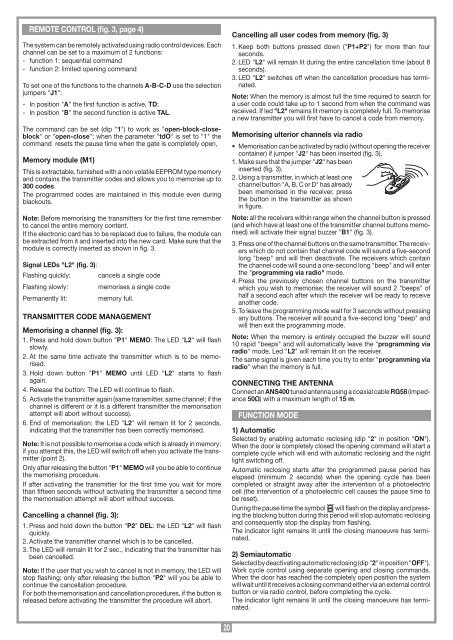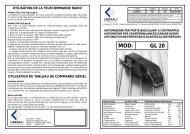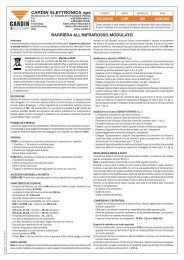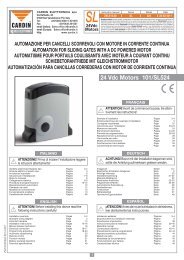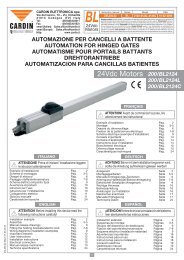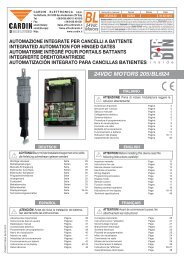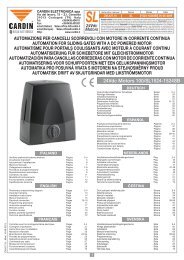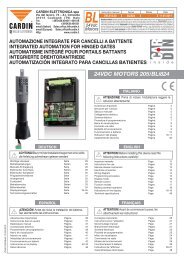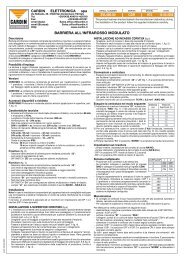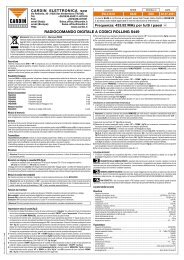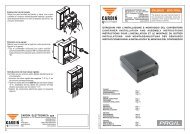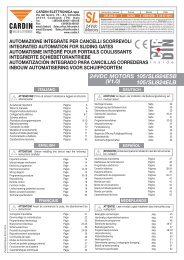2 - Cardin Elettronica
2 - Cardin Elettronica
2 - Cardin Elettronica
- No tags were found...
You also want an ePaper? Increase the reach of your titles
YUMPU automatically turns print PDFs into web optimized ePapers that Google loves.
REMOTE CONTROL (fig. 3, page 4)<br />
The system can be remotely activated using radio control devices. Each<br />
channel can be set to a maximum of 2 functions:<br />
- function 1: sequential command<br />
- function 2: limited opening command<br />
To set one of the functions to the channels A-B-C-D use the selection<br />
J1<br />
A TD;<br />
B TAL.<br />
1 open-block-closeblock<br />
open-close tdO <br />
command resets the pause time when the gate is completely open,<br />
Memory module (M1)<br />
This is extractable, furnished with a non volatile EEPROM type memory<br />
and contains the transmitter codes and allows you to memorise up to<br />
300 codes.<br />
The programmed codes are maintained in this module even during<br />
blackouts.<br />
Note: Before memorising the transmitters for the first time remember<br />
to cancel the entire memory content.<br />
If the electronic card has to be replaced due to failure, the module can<br />
be extracted from it and inserted into the new card. Make sure that the<br />
module is correctly inserted as shown in fig. 3.<br />
Signal LEDs "L2" (fig. 3):<br />
Flashing quickly: cancels a single code<br />
Flashing slowly: memorises a single code<br />
Permanently lit: memory full.<br />
TRANSMITTER CODE MANAGEMENT<br />
Memorising a channel (fig. 3):<br />
P1 MEMO L2 <br />
slowly.<br />
2. At the same time activate the transmitter which is to be memorised.<br />
P1 MEMO L2 <br />
again.<br />
4. Release the button: The LED will continue to flash.<br />
5. Activate the transmitter again (same transmitter, same channel; if the<br />
channel is different or it is a different transmitter the memorisation<br />
attempt will abort without success).<br />
L2 <br />
indicating that the transmitter has been correctly memorised.<br />
Note: It is not possible to memorise a code which is already in memory:<br />
if you attempt this, the LED will switch off when you activate the transmitter<br />
(point 2).<br />
P1 MEMO will you be able to continue<br />
the memorising procedure.<br />
If after activating the transmitter for the first time you wait for more<br />
than fifteen seconds without activating the transmitter a second time<br />
the memorisation attempt will abort without success.<br />
Cancelling a channel (fig. 3):<br />
P2 DEL L2 <br />
quickly.<br />
2. Activate the transmitter channel which is to be cancelled.<br />
3. The LED will remain lit for 2 sec., indicating that the transmitter has<br />
been cancelled.<br />
Note: If the user that you wish to cancel is not in memory, the LED will<br />
P2 <br />
continue the cancellation procedure.<br />
For both the memorisation and cancellation procedures, if the button is<br />
released before activating the transmitter the procedure will abort.<br />
Cancelling all user codes from memory (fig. 3)<br />
P1+P2 <br />
seconds.<br />
L2 <br />
seconds).<br />
L2 nated.<br />
Note: When the memory is almost full the time required to search for<br />
a user code could take up to 1 second from when the command was<br />
received. If led "L2" remains lit memory is completely full. To memorise<br />
a new transmitter you will first have to cancel a code from memory.<br />
Memorising ulterior channels via radio<br />
<br />
J2 <br />
J2 <br />
inserted (fig. 3).<br />
2. Using a transmitter, in which at least one<br />
<br />
been memorised in the receiver, press<br />
the button in the transmitter as shown<br />
in figure.<br />
Note: all the receivers within range when the channel button is pressed<br />
(and which have at least one of the transmitter channel buttons memo-<br />
B1 <br />
3. Press one of the channel buttons on the same transmitter. The receivers<br />
which do not contain that channel code will sound a five-second<br />
<br />
<br />
programming via radio" mode.<br />
4. Press the previously chosen channel buttons on the transmitter<br />
<br />
half a second each after which the receiver will be ready to receive<br />
another code.<br />
5. To leave the programming mode wait for 3 seconds without pressing<br />
<br />
will then exit the programming mode.<br />
Note: When the memory is entirely occupied the buzzer will sound<br />
programming via<br />
radio L2 <br />
programming via<br />
radio <br />
CONNECTING THE ANTENNA<br />
Connect an ANS400 tuned antenna using a coaxial cable RG58 (impedance<br />
50Ω) with a maximum length of 15 m.<br />
FUNCTION MODE<br />
1) Automatic<br />
2 ON<br />
When the door is completely closed the opening command will start a<br />
complete cycle which will end with automatic reclosing and the night<br />
light switching off.<br />
Automatic reclosing starts after the programmed pause period has<br />
elapsed (minimum 2 seconds) when the opening cycle has been<br />
completed or straight away after the intervention of a photoelectric<br />
cell (the intervention of a photoelectric cell causes the pause time to<br />
be reset).<br />
During the pause time the symbol will flash on the display and pressing<br />
the blocking button during this period will stop automatic reclosing<br />
and consequently stop the display from flashing.<br />
The indicator light remains lit until the closing manoeuvre has terminated.<br />
2) Semiautomatic<br />
2 OFF<br />
Work cycle control using separate opening and closing commands.<br />
When the door has reached the completely open position the system<br />
will wait until it receives a closing command either via an external control<br />
button or via radio control, before completing the cycle.<br />
The indicator light remains lit until the closing manoeuvre has terminated.<br />
MR<br />
20


